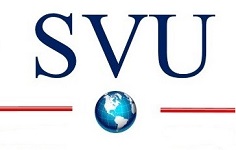SVU Scholar-in-Residence and Past SVU President Míla Rechcigl has just completed a unique, authoritative and intensely absorbing manuscript “Czech American Timeline: Chronology of Milestones in the History of Czechs in America.”
This comprehensive chronology depicts the dazzling epic history of Czech colonists, settlers, as well as early visitors, and their descendants, starting in 1519, with Hernán Cortés’ soldier Johann Berger in Mexico, and in 1528, the Jáchymov miners in Haiti, through the escapades of Bohemian Jesuits in Latin America in the 17th and 18th centuries, the Bohemian and Moravian pioneer settlers in New Amsterdam (New York) in the 17th century and the extraordinary mission work of Moravian Brethren in the 18th century, to the mass migration of Czechs from the Habsburg Empire in the second half of the 19th and the early part of the 20th centuries and the contemporary exodus of Czechs from Nazism and Communism.
The first entries in this amazing work deal with the discovery of the New World, which clearly show that Czechs were no too far behind. In any case, they were among the first to know about this, as the narrations below show:
CHRONOLOGY
some 3000 years ago
Between 1898 and 1903, during his scientific travels across America, Czech-American anthropologist Aleš Hrdlička (1869-1943), a native of Humpolec, Bohemia, became the first scientist to spot and document the theory of human colonization of the American continent from east Asia only some 3,000 years ago. He argued that the Indians migrated across the Bering Strait from Asia, supporting this theory with detailed field research of skeletal remains as well as studies of the people in Mongolia, Tibet, Siberia, Alaska, and Aleutian Islands. The findings backed up the argument which later involved into the theory of global origin of human species that was awarded by the Thomas Henry Huxley Award in 1927.
1466
The inhabitants of the Kingdom of Bohemia began to dream about the New World, ever since 1466, a quarter century before it was actually ‘discovered,’ when Václav Šašek of Bířkov had written his fantastic travelogue Deník o jízdě a putování pana Lva z Rožmitálu a z Blatné z Čech až na konec světa v letech 1465-67 (A diary about the voyage and the travels of Lev of Rožmitál and Blatná from Bohemia to the end of the world in 1465-67), in which he writes that, upon reaching the village Stella obscura at the end of the Pyrenean Peninsula, they learned about the land beyond the gigantic ocean.
1483
German scholar Franz v. Löher made the claim that Martin Behaim (1459-1507), from New Bohemia (Neuböhmen), in the vicinity of Nuremberg, a noted explorer and the creator of the first globe, rather than Columbus, or for that matter Amerigo Vespucci, was the discoverer of America. Löher celebrated Behaim, whom he considers to be a German, not only as the first European to view the coast of America off Brazil, in the year 1483, but also as the instructor in western navigation of both of the putative later discoverers and explorers, Columbus and Magellan. As the name indicates, Behaim was actually of Bohemian origin, whose ancestors having moved to Nuremberg from Bohemia.
1504
The news of the discovery of the New Word reached the Kingdom of Bohemia as early as the first decade of the 16th century, during the reign of Vladislav II the Jagiellonian (1471-1516), when an early print in the Czech language, Spis o nowych zemiech A o novem swietie O niemžto gsme prwe žadne znamosti nemeli Ani kdy tzo slychali (Treatise about the new lands and the New World about which we had no knowledge nor ever heard of), was published in Plzeň, Bohemia in 1504, by one of the first known Bohemian printers, Mikuláš Bakalář. What is astounding is the fact that it came in the same year as the first printed Latin version.
1519
Johann Berger (ca 1502-d.), b. Osoblaha (Hotzenplotz), Moravia took part as a soldier in the expedition of Hernán Cortés (1485-1547) against Aztecs. He was presumably 17 years of age when he arrived in Mexico (Spaniards landed at Vera Cruz on March 1519), where he fell into French captivity. After being freed he took part in the exploration and battles in Venezuela and Columbia and subsequently returned to Mexico.
1528
The Welser family, Augsburg merchants, was granted rights to colonize most of north-eastern South America by Charles V. In July 1528, the first group of miners (16 men and 1 woman), largely from Bohemia and Silesia, left for America, via Antwerp and Seville in December, sailing off for Santo Domingo. Among them was Hans Trumpel (* aft.1500) from Jáchymov, Bohemia. Two months later the second group of miners (24 men) followed. Altogether some 50 volunteers came to Santo Domingo. It was an unsuccessful venture, number of people died and the remainder returned to Europe.
1585
Joachim Gans (ca 1560-d.), of Prague, took part in the first British colonization effort in America. On July 13, 1585, a group of 108 English colonists, including Joachim Gans, led by Sir Richard Grenville, reached Roanoke Island, Virginia (now in North Carolina). Joachim Gans was a metallurgist by profession who was sent along to seek ores like silver and gold. The expedition returned to Europe the following year without much success.
Pre-ordering the Book
Since only a limited number of copies will be printed, SVU members and other interested people are encouraged to order the book beforehand. With sufficient orders there may be a discount. Place your orders: svu.one@gmail.com




